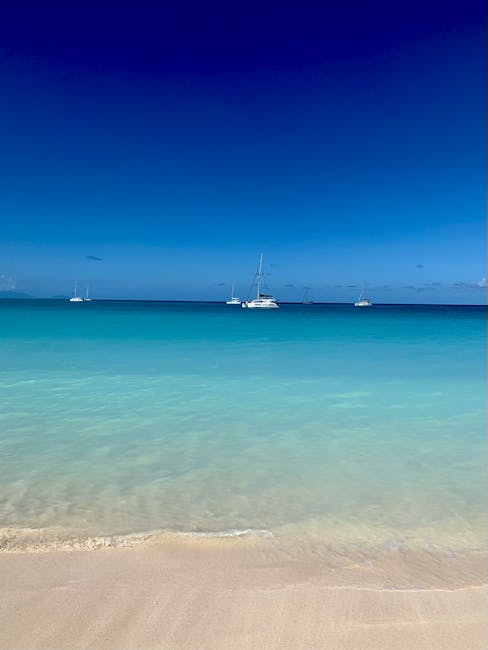Imagine sailing away on a luxurious yacht, feeling the gentle breeze in your hair and the warmth of the sun on your face. The vast expanse of the open sea stretches out before you, beckoning you to explore its hidden treasures. But have you ever wondered, just how far can yachts travel? In this intriguing exploration of nautical adventures, we will delve into the world of yachting and unravel the secrets of how far these magnificent vessels can take us.
Yachts, with their sleek designs and state-of-the-art technology, have revolutionized the way we experience the open waters. From the glamorous Mediterranean to the remote islands of the Pacific, these floating paradises offer the ultimate escape from the everyday hustle and bustle. But their range is not merely limited to nearby destinations. Prepare to be amazed as we embark on a journey to discover the incredible distances that yachts can cover, pushing the boundaries of exploration and adventure. So, fasten your seatbelt (or should I say, life jacket?) and get ready to set sail on an enchanting voyage into the world of yachts and their boundless horizons.
Yachts can travel long distances depending on their size, fuel capacity, and the type of yacht. Some yachts can travel thousands of nautical miles without refueling, while others may have a shorter range. It is important to consider factors such as fuel efficiency, cruising speed, and available amenities when determining how far a yacht can travel.

How Far Can Yachts Travel: A Comprehensive Guide
In the world of luxury travel, yachts have long been synonymous with opulence and adventure. But if you’re considering embarking on a yacht journey, one question that may come to mind is: how far can yachts actually travel? In this informative guide, we will delve into the factors that determine a yacht’s range, the different types of yachts available, and some key considerations to keep in mind when planning your voyage.
Factors Affecting a Yacht’s Range
When it comes to determining how far a yacht can travel, several factors come into play. These factors include:
1. Fuel Capacity and Efficiency
The most obvious factor that affects a yacht’s range is its fuel capacity and efficiency. Yachts typically run on diesel fuel, and the more fuel a yacht can carry, the farther it can travel. Additionally, the efficiency of the engines plays a crucial role in determining how much distance can be covered on a full tank of fuel.
2. Hull Design
The design of a yacht’s hull also impacts its range. Yachts with a more streamlined hull design tend to be more fuel-efficient, allowing them to cover longer distances. The shape, weight distribution, and materials used in the construction of the hull all contribute to the overall performance and range of the yacht.
3. Engine Power
The power of a yacht’s engine is another significant factor to consider. Yachts with more powerful engines can reach higher speeds, but this often comes at the cost of increased fuel consumption. Finding the right balance between power and fuel efficiency is crucial for maximizing a yacht’s range.
Different Types of Yachts and Their Ranges
Yachts come in various sizes and types, each with its own range capabilities. Here are three common types of yachts and their typical ranges:
1. Motor Yachts
Motor yachts, also known as power yachts, are equipped with powerful engines that allow them to travel at high speeds. Depending on the size and fuel capacity, motor yachts can typically cover distances ranging from 500 to 5,000 nautical miles. Larger motor yachts often have the capability to cross oceans.
2. Sailing Yachts
Sailing yachts rely on wind power and are equipped with sails for propulsion. The range of a sailing yacht largely depends on the wind conditions and the ability of the crew to harness the wind efficiently. On average, sailing yachts can cover distances ranging from 100 to 1,000 nautical miles.
3. Expedition Yachts
Expedition yachts are designed for long-range cruising and exploration. These yachts are built to withstand rough seas and adverse weather conditions, allowing them to venture to remote destinations. With larger fuel capacities and more efficient engines, expedition yachts can typically travel distances exceeding 10,000 nautical miles.
Considerations for Planning Your Voyage
Before embarking on a yacht journey, there are several important considerations to keep in mind:
1. Itinerary Planning
When planning your yacht trip, carefully consider the distances you wish to cover and the destinations you want to visit. Take into account the range of your yacht and ensure that it aligns with your desired itinerary.
2. Fuel Stops and Refueling
If you’re planning a longer voyage, it’s essential to identify suitable fuel stops along your route. Research the availability of fueling stations and plan your refueling stops accordingly to ensure a smooth and uninterrupted journey.
3. Weather Conditions
Weather conditions can significantly impact a yacht’s range and overall safety. Stay updated on weather forecasts and plan your voyage accordingly. Avoid sailing in adverse weather conditions and ensure you have the necessary safety equipment on board.
4. Crew and Expertise
If you’re not an experienced sailor, it’s advisable to hire a professional crew or captain who can navigate the yacht safely and efficiently. A knowledgeable crew can also assist in optimizing fuel consumption and maximizing the yacht’s range.
By considering these factors and planning your voyage carefully, you can embark on a yacht journey with confidence, knowing how far your yacht can travel and making the most of your luxurious adventure.
Frequently Asked Questions
Here are some commonly asked questions about how far yachts can travel:
1. How far can yachts typically travel?
Yachts are designed to be able to travel long distances, with their range depending on various factors. Generally, larger yachts with larger fuel capacities can travel further than smaller ones. On average, most yachts can comfortably travel around 1,000 to 2,000 nautical miles before needing to refuel or restock supplies.
However, it’s important to note that the range of a yacht can be influenced by variables such as weather conditions, speed, engine efficiency, and the amount of fuel and supplies carried on board. Experienced yacht owners and captains plan their routes carefully, considering these factors to ensure a safe and enjoyable journey.
2. Can yachts cross oceans?
Yes, many yachts are capable of crossing oceans and embarking on long-distance voyages. Ocean-crossing yachts, also known as bluewater yachts, are specifically designed and equipped to handle the challenges of extended offshore journeys. These yachts have features like reinforced hulls, ample fuel and water storage, and advanced navigation systems.
When planning an ocean crossing, yacht owners and crews carefully prepare by considering weather patterns, safety measures, and emergency protocols. They also ensure that the yacht is properly maintained and equipped with all the necessary supplies and equipment for a successful voyage across the open seas.
3. Are there any limitations on yacht travel?
While yachts can travel great distances, there are some limitations to consider. Firstly, yachts have finite fuel and water capacities, so they will eventually need to refuel and restock. The availability of fuel and supplies along the intended route should be considered when planning a long-distance journey.
Additionally, yachts are subject to international maritime laws and regulations. Some countries may have restrictions on where yachts can travel or require certain permits and documentation. It’s important to research and comply with these regulations to avoid any legal issues during a yacht trip.
4. How do yachts ensure their safety during long journeys?
Safety is a top priority for yacht owners and crews during long journeys. Yachts are equipped with various safety features and equipment, including life rafts, life jackets, fire suppression systems, and emergency communication devices. Crew members are trained in safety procedures and often have experience in handling different situations at sea.
Before embarking on a long journey, yacht crews conduct thorough safety checks and inspections to ensure that all systems are in working order. They also monitor weather conditions, maintain regular communication with shore-based support, and have contingency plans in place to handle any emergencies that may arise during the voyage.
5. Can yachts travel to remote destinations?
Yachts offer the flexibility to travel to remote and secluded destinations that may not be easily accessible by other means of transportation. With their ability to navigate shallow waters and anchor in secluded bays, yachts can reach places that are off the beaten path.
However, when planning a trip to a remote destination, yacht owners need to consider factors such as availability of supplies, access to medical facilities, and potential challenges in terms of navigation and communication. Proper preparation, including researching the destination and understanding its specific requirements, is essential to ensure a successful voyage to remote areas.
In conclusion, the distance that yachts can travel is truly remarkable. With advancements in technology and the ability to carry ample fuel and supplies, yachts have the capability to traverse vast oceans and explore remote corners of the world. The limit to how far yachts can travel is often determined by the imagination and courage of the sailors on board.
However, it is important to note that the range of a yacht’s travel is also influenced by various factors such as the size and design of the vessel, the weather conditions, and the skill and experience of the crew. While some yachts are built for long-distance voyages and can easily cross oceans, others are better suited for coastal cruising. Ultimately, the extent to which a yacht can travel depends on the purpose and specifications of the individual vessel.
In summary, yachts have the potential to embark on incredible journeys, pushing the boundaries of exploration and adventure. The freedom to navigate vast expanses of water is a testament to human ingenuity and the desire to venture into the unknown. So, whether it is a short coastal trip or a daring circumnavigation, the possibilities for yacht travel are limited only by the ambition and determination of those who dare to set sail.

















